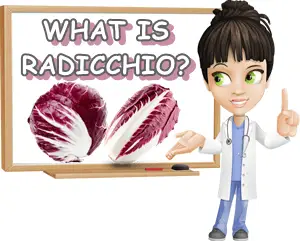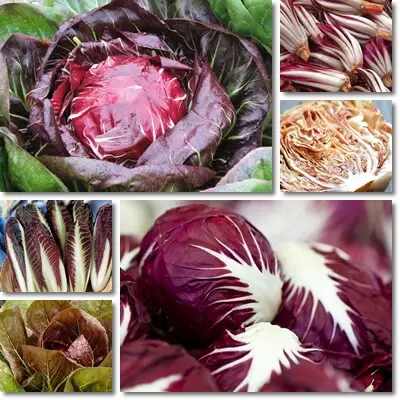Radicchio is a variety of chicory.
Also called Italian chicory, it’s one of the most popular salad vegetables in Italian cuisine besides Florence fennel.
But what is radicchio more exactly? How does it fit in with the rest of chicories? Is there just one type or does it come in more varieties?
Radicchio is a botanic and culinary vegetable
One of the first things to know about radicchio is that it’s both a botanical and a culinary vegetable.
That means that it’s a true vegetable, and used as one in the kitchen.
The official botanical name for radicchio is Cichorium intybus, but in regular usage it’s called simply radicchio, or Italian radicchio to best reflect its now traditional status in Italian cuisine and food culture.

Radicchio is a type of chicory
Of all the facts to know about radicchio, probably the most important is that it’s a type of chicory.
Even is scientific name clearly indicates where it comes from: Cichorium intybus > chicories.
But why is this the most important thing to know? Because chicories are daisy-family plants nd known allergens which meaans that radicchio too has the potential to cause allergic reactions that could range from mild (a rash) to severe (anaphylactic shock).
Radicchio is a variety of common chicory
Cichorium intybus is the scientific/botanical name for radicchio. The name is revealing of its status among chicories: radicchio is a variety of common chicory.
That means it’s part of one of the most common species of chicory. Related to radicchio are other common chicories such as:
- Root chicory whose root is used to make a plant coffee substitute known as chicory coffee. It occurs naturally in the wild and is cultivated commercially.
- Cultivated leaf chicories: asparagus chicory (also puntarelle), also endives (Belgian endive, blanched endive), variegated radicchio and radichetta.
- Wild leaf chicory occurring naturally in the wild, and traditionally consumed throughout Europe and India as a forage food similar to sorrel.
Also read about the benefits of chicory root coffee.
Also read about the side effects of chicory root coffee.

Radicchio is a salad vegetable
Radicchio is primarily consumed raw, in salads – this makes it a salad vegetable.
Raw radicchio is perfectly edible and safe to eat in normal food amounts (if you are not allergic).
It’s also nutritious and full of benefits for health.
Of course, it can be cooked too – if cooked, radicchio is preferred grilled.
Alternatively, it can be lightly cooked, boiled or stewed, and added to risotto or pasta dishes, boiled in soups or simmered down and used as a filling for pastry products or vegetarian lasagna. It can be added on top of pizza and even pickled.
Radicchio is a leaf vegetable/leaf chicory
Radicchio is classified as a leaf vegetable or leaf chicory. What this means is that it’s consumed for its leaves. With its thick, meaty, crisp leaves, radicchio is not your ordinary leafy salad vegetable, but nonetheless it’s one.
Radicchio is a perennial plant
A perennial is a plant that lives for many years, at least 3 or more years, depending on the species.
Radicchio too is a perennial meaning that once you plant it, it will live for at least 3 or more years.
During that time you can harvest it for food regularly. It’s also relatively low maintenance. In this respect, it’s an economical vegetable to grow yourself.
Radicchio is a red vegetable
That’s not hard to tell. But although it falls into the larger category of red vegetables, radicchio is not actually red.
It’s really magenta which is a deeper purplish red color.
The exact shade may vary slightly according to the age of the vegetable at harvest time, with very young plants having slightly less of a deeper pigment.
Also, radicchio is not completely magenta either – its mostly magenta, but with crisp-white veins and stalk.
Radicchio is a bitter vegetable
The taste of radicchio is not consistent across all vegetables. And that’s actually normal since factors such as variety, growing conditions, region of cultivation and climate, time of planting and harvesting, as well as the age of the vegetable at harvest time can have a significant impact on how food tastes.
Under normal conditions, radicchio should taste bitter, and also peppery. But the reality is that bitter is not everyone’s cup of tea.
This is why most radicchio plants are harvested before they reach maturity and get bitter, and cultivars selected so that the bitter taste is not very pregnant.
If I’m being honest, a lot of radicchio you’ll buy will taste close to bland, with only faint bitter notes and barely any spiciness.
But you might just like it that way and that’s perfectly okay.
Radicchio is not just one variety
There’s Chioggia radicchio, Treviso radicchio, tardivo radicchio, Castelfranco or variegated radicchio and different cultivars of some of these varieties.
Chioggia is the radicchio variety that looks the most like a red cabbage with a dense head of tightly-packed, magenta, cabbage-like leaves.
The Treviso radicchio looks like a magenta and white Belgian endive, while the variegated radicchio looks more like a leafy, green salad.
See how to tell the difference between radicchio and red cabbage.
Radicchio is not an endive, although some radicchios look like endives
Radicchio is a type of chicory, but because the most popular variety looks like a magenta (and white) Belgian endive, radicchios are mistakenly called endives.
Radicchio is, in fact, not an endive, but a chicory. In fact, Belgian endives too are chicories, not endives, despite their common name saying otherwise.
See my guide to chicories and endives with pictures for all the different types of chicory greens.
Radicchio is a diet vegetable
There are only 23 calories per 100 grams of raw radicchio, less than 4.5 grams of carbs, only 0.6 grams of natural sugars and 0.25 grams of fat. In fact, radicchio along with bulb fennel (Florence fennel) are the preferred foods for weight loss diets in Italian food culture.
Radicchio is a natural digestive
The fact that radicchio is bitter to the taste, or should be, makes it a digestif-type of food. That is, eating bitter radicchio stimulates digestive juices and aids digestion.
